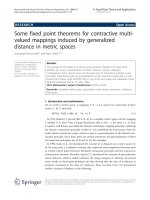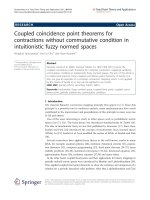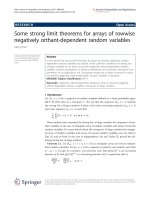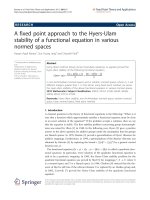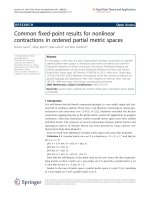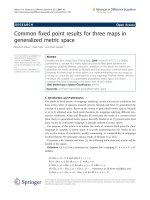Báo cáo hóa học: " COMMON FIXED POINT THEOREMS FOR COMPATIBLE SELF-MAPS OF HAUSDORFF TOPOLOGICAL SPACES" ppt
Bạn đang xem bản rút gọn của tài liệu. Xem và tải ngay bản đầy đủ của tài liệu tại đây (509.91 KB, 9 trang )
COMMON FIXED POINT THEOREMS FOR COMPATIBLE
SELF-MAPS OF HAUSDORFF TOPOLOGICAL SPACES
GERALD F. JUNGCK
Received 13 July 2004 and in revised form 3 February 2005
The concept of proper orbits of a map g is introduced and results of the following type
are obtained. If a continuous self-map g of a Hausdorff topological space X has relatively
compact proper orbits, then g has a fixed point. In fact, g has a common fixed point with
every continuous self-map f of X which is nontrivially compatible with g. A collection of
metric and semimetric space fixed point theorems follows as a consequence. Specifically,
a theorem by Kirk regarding diminishing orbital diameters is generalized, and a fixed
point theorem for maps with no recurrent points is proved.
1. Introduction
Let g beamappingofatopologicalspaceX into itself. Let N denote the set of positive
integers and ω = N ∪{0}.Forx ∈ X, ᏻ(x)iscalledtheorbit of g at x and defined by
ᏻ(x) ={g
k
(x):k ∈ ω},whereg
o
(x) = x. Thus, if n ∈ ω,theorbitofg at g
n
(x)istheset
ᏻ(g
n
(x)) ={g
k
(x):k ∈ ω and k ≥ n}.(Clearly,ᏻ(g
n
(x)) ⊂ ᏻ(x)forn ∈ N.) And if X has
a metric or semimetric d, we will designate the diameter ofasetM ⊂ X by δ(M) which
of course is defined δ(M) = sup{d(x, y):x, y ∈ M}.
The purpose of this paper is to introduce the concept of proper orbits and to dem-
onstrate its role in obtaining fixed points. (We use cl(A) to denote the closure of the
set A.)
Definit ion 1.1. Let g be a self-map of a topological space X and let x
∈ X.Theorbitᏻ(x)of
g at x is proper if and only if ᏻ(x) ={x} or there exists n = n
x
∈ N such that cl(ᏻ(g
n
(x)))
is a proper subset of cl(ᏻ(x)). If ᏻ(x)isproperforeachx ∈ M ⊂ X,wewillsaythatg has
proper orbits on M.IfM = X,wesayg has proper orbits.
The concept of proper orbits generalizes the concept of diminishing orbital diameters,
which was introduced by Belluce and Kirk [1] in 1969. They introduced the concept of
mappings with diminishing orbital diameters to obtain fixed point theorems for non-
expansive self-maps of metric spaces. A self-map g of a metric space X has diminishing
orbital diameters if for each x
∈ X, δ(ᏻ(x)) < ∞, and whenever δ(ᏻ(x)) > 0, there exists
n = n
x
∈ N such that δ(ᏻ(x)) >δ(ᏻ(g
n
(x))). (If the given property holds for a specific x,
Copyright © 2005 Hindawi Publishing Corporation
Fixed Point Theory and Applications 2005:3 (2005) 355–363
DOI: 10.1155/FPTA.2005.355
356 Common fixed points for compatible maps
we will say that ᏻ(x) has diminishing diameters.) Subsequently Kirk [13] (1969) extended
the concept to more general mappings. In particular, he proved the following interesting
result for a metric space M.
Theorem 1.2 (Kirk [13]). Suppose M is compact and g : M → M is continuous with dimin-
ishing orbital diameters. Then for each x ∈ M,somesubsequence{g
n
k
(x)} of t he sequence
{g
n
(x)} of ite rates of x has a limit which is a fixed point of g.
One purpose of this paper is to extend Theorem 1.2, and in the following manner.
The underlying space will be a Hausdorff topological space. Instead of requiring that the
space M be compact, we will require that the orbits be relatively compact. And we will
replace the requirement that orbits have diminishing diameters by the demand that they
be proper. Moreover, it will be shown that g has a common fixed point with every f
∈ K
g
,
a set we now define.
Definit ion 1.3. If g is a continuous self-map of a topological space X, K
g
is the set of all
continuous maps f : X → X such that M ={x ∈ X : fx= gx} =∅and fgx= gfxfor
x ∈ M.(K
g
=∅, since g ∈ K
g
.)
We will expand further on these concepts, but first note that the motivation behind
our approach and our interest in the set K
g
is the following theorem.
Theorem 1.4 [10]. A continuous self-map g of I = [0,1] has a common fixed point with
every function in K
g
if and only if every periodic point of g is a fixed point of g (i.e., g
k
(x) =
x ⇒ g(x) = x).
To appreciate the significance of Theorem 1.4 in the present context, suppose there
exist x ∈ I and k ∈ N such that k>1, g
k
(x) = x and g
i
(x) = x for 0 <i<k.Thenitisclear
that ᏻ(x) = ᏻ(g
n
(x)) ={x} for all n ∈ N.Thus,g does not have proper orbits. So, if the
function g of Theorem 1.4 has proper orbits, then g has a common fixed point with each
f ∈ K
g
. We now show that this implication extends to very general settings.
2. Preliminaries
We first review background regarding semimetric spaces and compatible maps. Semimet-
ric spaces give us a vehicle for extending metric space results. Moreover, since semimetric
spaces are first countable and orbits are virtually sequences, semimetric spaces provide a
natural and relatively unrestricted arena for examples and results involving orbits.
A semimetric on a set X is a function d : X
× X → [0,∞)suchthatd(x, y) = 0ifand
only if x = y,andd(x, y) = d(y,x)forx, y ∈ X.Forp ∈ X and > 0weletS(p,) ={x ∈
X : d(x, p) <
}
. A semimetric space is a pair (X;d) in which X is a Hausdorff topological
space and d is a semimetric on X.ThetopologyonX is the family t(d) ={U ⊂ X : p ∈
U ⇒ S(p,) ⊂ U for some > 0}. We require that the topological interior of S(p,)be
nonempty and contain p; that is, there exists U ∈ t(d)suchthatp ∈ U ⊂ S(p,). Con-
sequently, a sequence {x
n
} in X converges in t(d)top ∈ X, denoted x
n
→ p,ifandonly
if d(x
n
, p) → 0. And a function (map) g : X → X is continuous if and only if gx
n
→ gx
whenever x
n
→ x.See[5, 11] for further details on semimetric spaces.
Gerald F. Jungck 357
Compatible maps were introduced by Jungck [8] in 1986 for metric spaces as a gener-
alization of commuting maps. The concept proved useful in obtaining generalizations of
established fixed point theorems. The definition for a semimetr i c space (X;d)isformally
thesameandisasfollows.Maps f ,g : X → X are compatible if and only if d(gfx
n
, fgx
n
)
→ 0whenever{x
n
} is a sequence in X such that fx
n
,gx
n
→ p for some p ∈ X.If f and
g are compatible and do have a coincidence point, f and g are nontrivially compatible.
An immediate consequence of the definition is that compatible maps commute at coinci-
dence points, a property we highlight. So if f and g are continuous nontrivially compat-
ible self-maps of X,then f ∈ K
g
and g ∈ K
f
.Infact,if f and g are continuous and X is
compact, then f and g are compatible if and only if fx= gx implies that fgx= gfx. This
result is proved in [9] for metric spaces but also holds for semimetric spaces (the triangle
inequality is not used). (See [8, 9] for properties of compatible maps.)
Before continuing, we pay for the freedom granted by semimetric spaces. Let A be a
subset of a semimetric space. Since we have no triangle inequality, it is not necessarily
true—as the next example shows—that δ(A) = δ(cl(A)). (Kirk’s proof of Theorem 1.2
appealed to this “metric space” equality.)
Example 2.1. Let X
= [0,1] and define d(x, y) =|x − y| if x, y ∈ (0,1] and d(b,0) = d(0,
b) = 2b if b ∈ [0,1]. Then δ((0,1/2]) = 1/2, whereas δ([0,1/2]) = δ(cl((0,1/2])) = 1.
Note that the topological space (X, t(d)) is metrizable but d is not a metric.
With A = (0,1/2] and B = [0,1/2], Example 2.1 also shows that in the context of semi-
metric spaces, even though A ⊂ B and δ(A) <δ(B), cl(A) may not be a proper subset of
cl(B).
The above observations prompt the following definition.
Definit ion 2.2. Let (X;d) be a semimetric space. A mapping g : X
→ X has orbits with
diminishing closure diameters if and only if for each x ∈ X, δ(cl(ᏻ(x))) < ∞, and whenever
δ(cl(ᏻ(x))) > 0, there exists n ∈ N such that δ(cl(ᏻ(x))) >δ(cl(ᏻ(g
n
(x)))).
Of course, if (X;d)isasemimetricspaceandg : X → X has orbits with diminish-
ing closure diameters (d.c.d.), then g has proper orbits. For suppose ᏻ(x) ={x}.Then
δ(cl(ᏻ(x)))>0. Since g has d.c.d., there is an n∈N such that δ(cl(ᏻ(g
n
(x))))<δ(cl(ᏻ(x))).
But this implies that cl(ᏻ(g
n
(x))) is a proper subset of cl(ᏻ(x)), as desired.
Observe also that in metric spaces (X, d) Definition 2.2 reduces to that of diminishing
orbital diameters (d.o.d.). Thus, if g has d.o.d. on (X,d), then g has proper orbits.
3. Results and examples
We now state and prove our results. The statements and proofs of the initial theorems and
corollaries are completely topological in nature. The proof of our first theorem repeats an
argument used by Schwartz in the proof of Proposition 1 on page 353 of [18].
Theorem 3.1. Let X beaHausdorff topological space and let g : X
→ X be continuous. If
g has relatively compact proper orbits, then any nonempty g-invar iant closed subset of X
contains a fixed point of g. Specifically, the closure of each orbit ᏻ(x) has a fixed point of g.
358 Common fixed points for compatible maps
Proof. Let M be a nonempty g-invariant closed subset of X,andletx ∈ M. By hypothesis,
g
n
(x) ∈ M for each n ∈ N so that ᏻ(x) ⊂ M.Thencl(ᏻ(x)) ⊂ M since M is closed. Clearly,
g(ᏻ(x)) ⊂ ᏻ(x); therefore the continuity of g implies that g(cl(ᏻ(x))) ⊂ cl (g(ᏻ(x))) ⊂
cl(ᏻ(x)) (⊂ M). But cl(ᏻ(x)) is compact by hypothesis. Consequently, cl(ᏻ(x)) is a non-
empty g-invariant compact subset of M. A Zorn’s lemma argument produces a minimal
nonempty g-invariant compact subset A of M.
Let a ∈ A.SinceA is g-invariant and closed, cl(ᏻ(a)) ⊂ A.Asabove,g(cl(ᏻ(a))) ⊂
cl(O(a)) (⊂ A). But then cl(ᏻ(a)) is a g-invariant nonempty compact subset of A and thus
of M. By the minimality of A,cl(ᏻ(a)) = A. Consequently, A = cl(ᏻ(g
n
(a))) for n ∈ ω,
since a was an arbitrary element of A and g
n
(a) ∈ A.Thus,cl(ᏻ(a)) = cl(ᏻ(g
n
(a))) for all
n ∈ N, and therefore ᏻ(a) ={a} since ᏻ(a)isproper.Weconclude,g(a) = a,anda is the
desired fixed point of M.
Moreover, the above argument shows that for each x ∈ X,cl(ᏻ(x)) is a nonvoid g-
invariant compact (and therefore, closed) subset of X.Assuch,cl(ᏻ(x)) contains a fixed
point of g by the preceding result.
Corollary 3.2. A continuous self-map g of a Hausdorff topological space X has a fixed
point if and only if there exist x ∈ X such that cl(ᏻ(x)) is compact and g has proper orbits
on cl(ᏻ(x)).
Proof. If g(x)
= x,thenᏻ(x) ={x}=cl(ᏻ(x)). Thus cl(ᏻ(x)) is compact, and the only
orbit of g on cl(ᏻ(x)), namely {x}, is proper. So the condition is necessary.
To see that the condition is sufficient, let x ∈ X such that cl(ᏻ(x)) is compact and g
has proper orbits on cl(ᏻ(x)). Since g is continuous, cl(ᏻ(x)) is g-invariant. Therefore,
we apply Theorem 3.1 with X = M = cl(ᏻ(x)). Since g has relatively compact orbits on
cl(ᏻ(x)) (cl(ᏻ(x)) is compact) and g has proper orbits on cl(ᏻ(x)) by hypothesis, the
conclusion follows.
Why would it not be sufficient i n the above result to merely require that there exist a
proper orbit ᏻ(x)ofg having compact closure? Consider the following.
Example 3.3. Let 0 <a<1. Let X be the planar annulus defined in polar coordinates by
X ={(r,θ):0<a≤ r ≤ 1}.
Define g : X → X by g((r,θ)) = (r/2+1/2,θ + π). Then for r<1andn ∈ N, g
n
((r,θ)) =
(r/2
n
+
n
k=1
(1/2
k
),θ + nπ).
Clearly, g
2n
((r, θ)) → (1,θ)andg
2n+1
((r, θ)) → (1,θ + π), and consequently, cl(ᏻ((r,
θ))) = ᏻ((r,θ)) ∪{(1,θ),(1,θ + π)}.Thusforallr<1, ᏻ((r,θ)) is proper and has com-
pact closure; but g does not have proper orbits on cl(ᏻ((r,θ))) since ᏻ((1,θ)) ={(1,θ),(1,
θ + π)} (i.e., g is periodic of period 2 on r = 1). And of course, g has no fixed points. Note
also that the diameter of every orbit in X is 2, and t herefore no orbit in X has d.o.d.
The following example satisfies the hypothesis of Corollary 3.2 and thus the mapping
g of this example has a fixed point.
Example 3.4. Let X = [−1,1] with the usual metric and let g(x) =−x
1/3
for x ∈ X.Itis
easy to verify that every point in (−1,1) has a proper orbit. However, x = 0, the only fixed
point of g, is the only point in X with proper orbits on the closure of its orbit {0}.
Gerald F. Jungck 359
We now apply Theorem 3.1 to obtain information regarding the set K
g
,ofDefinition
1.3.
Corollary 3.5. Let g be a continuous self-map of a Hausdorff topological space X.Ifg has
relatively compact proper orbits, then g has a common fixed point with each f ∈ K
g
.
Proof. Let f ∈ K
g
,andletM ={x ∈ X : fx= gx}.ThenM =∅by definition of K
g
.If
x ∈ M,then fx= gx.Since f ∈ K
g
, f
2
x = fgx= gfx= g
2
x.But f
2
x = gfximplies that
fx∈ M,and fgx= g
2
x implies that gx ∈ M.Thus f (M),g(M) ⊂ M.
It is well known that M is closed. Thus, M is a nonempty g-invariant closed subset of
X.ByTheorem 3.1, M has a fixed point p of g. By definition of M, f (p) = g (p) = p,and
p is the promised common fixed point.
For purposes of reference we now combine Theorem 3.1 and Corollary 3.5.
Theorem 3.6. Let g be a continuous self-map of a Hausdorff topological space X.Ifg has
relatively compact proper orbits, then g has a common fixed point with each function f ∈ K
g
.
Moreover, each nonempty g-invariant closed subset of X has a fixed point of g.Specifically,
the closure of each orbit ᏻ(x) contains a fixed point of g.
If a Hausdorff topological space X is compact, then all orbits of a self-map of X are
relatively compact. Consequently, Theorem 3.6 yields the following result which stresses
the role of proper orbits.
Corollary 3.7. Any continuous self-map g of a compact Hausdorff topological space with
proper orbits has a fixed point. In fact, the closure of each orbit contains a fixed point of g.
Moreover, g has a common fixed point with each f
∈ K
g
.
If g is a self-map of a topological space X,apointx ∈ X is called a re current point if
and only if x is a limit point (accumulation point) of ᏻ(x). And x is a nontrivial periodic
point if and only if g
k
x = x for some k ∈ N but gx = x.
Theorem 3.8. Let g be a continuous self-map of a Hausdorff topological space X.Ifg has
no recurrent or nontrivial periodic points, then g has proper orbits.
Proof. We show ᏻ(x)isproper.Ifx = gx, then we are done. So let x = gx.Sincex is not a
recurrent point, there exists a neighborhood N(x)ofx such that N(x) ∩ (ᏻ(x)\{x}) =∅.
By hypothesis x is not a p eriodic point, so ᏻ(x)\{x}=ᏻ(gx). Thus N(x) ∩ ᏻ(gx) =∅,
that is, x/∈ cl (ᏻ(gx)). Hence cl(ᏻ(gx)) = cl (ᏻ(x)) which means ᏻ(x)isproper.
Corollary 3.7 and Theorem 3.8 yield the following.
Corollary 3.9. Any continuous self-map of a compact Hausdorff topological space which
has no recurrent or nontrivial periodic points has a fixed point.
Of course, if in Corollary 3.9 g has nontrivial periodic points, g may have no fixed
points. Define g by g(x)
= 1 − x for x ∈ X = [0,1/4] ∪ [3/4,1]. Then g is a continuous
self-map of a compact space X of period 2 which has neither recurrent points nor fixed
points.
As an application of Corollary 3.9, consider the following.
360 Common fixed points for compatible maps
Example 3.10. Let C ={(r,θ):θ ∈ R} be a circle in polar coordinates of radius r>0and
let g be a rational rotation of C.Thus,g((r,θ)) = (r,θ + φ) for some rational φ ∈ (0,2π).
Then every point of C is a recurrent point of g. To see this, first note that g
n
((r,θ)) =
(r,θ + nφ)forn ∈ N and that (r, θ + nφ) = (r,θ +2kπ)fornon,k ∈ N since φ is ra-
tional. Thus, g has no fixed or periodic points so that g has a recurrent point in C by
Corollary 3.9. We leave it to the reader to show that therefore every point of C isare-
current point of g. Consequently, if A is a rational rotation of the plane about the origin,
then every point of R
2
−{(0,0)} is a recurrent point of A.
Aself-mapg ofaspaceX is compact [4]ifandonlyifX hasacompactsubsetY and
g(X) ⊂ Y .
Corollary 3.11. Let g be continuous self-map of a Hausdorff topological space with proper
orbits. If g is compact, the n g has a fixed point; indeed, g has a common fixed point with each
f ∈ K
g
.
Proof. Since g is compact there exists a compact set Y ⊂ X such that g(X) ⊂ Y.Then
g(Y) ⊂ g(X) ⊂ Y, and therefore Y is g invariant and compact. Since g has proper orbits,
the restriction of g to Y satisfies the hypothesis of Corollary 3.7.
Corollary 3.12. Let g be a continuous self-map of a first countable Hausdorff topological
space X.Ifg has relatively compact proper orbits, then g has a common fixed point with each
f ∈ K
g
. Moreover, for each x ∈ X,thereisasubsequenceof{g
n
(x) } which converges to a
fixed point of g.
Proof. Corollary 3.12 is an immediate consequence of Theorem 3.6, except for possibly
the concluding statement. This last statement follows by noting that by Theorem 3.6,
for each x ∈ X,cl(ᏻ(x)) contains a fixed point p of g.SinceX is first countable, there
is a sequence in ᏻ(x) which converges to p. This sequence can be chosen so as to be a
legitimate subsequence of {g
n
(x)}.
Since any semimetric space is Hausdorff and first countable we have:
Corollary 3.13. Let (X;d) be a semimetric space and let g : X → X be continuous. If g
has relatively compact orbits with proper orbits or diminishing closure diameters, then g has
a common fixed point with each f ∈ K
g
. Moreover, for each x ∈ X,somesubsequenceof
{g
n
(x)} converges to a fixed point of g.
As noted above, in metric spaces diminishing orbital diameters (d.o.d.) yield orbits
with diminishing closure diameters (d.c.d.) and therefore, proper orbits. Thus, Cor ollary
3.13 is valid for metric spaces (X,d) with d.c.d. replaced by d.o.d.
The next example shows that common fixed points of g and the members of K
g
in
Corollary 3.13 need not be unique, even if X = [0,1] with the usual metric. It also suggests
that K
g
can be large.
Example 3.14. Let X = [0,1] and d(x, y) =|x − y|.Define f (x) = 2x − x
2
and g(x) = x
2
.
The common fixed points of f and g are 0 and 1 and are their only coincidence points. In
general fg= gf, but since f and g clearly commute at 0 and 1, f and g are nontrivially
compatible. If x ∈ [0,1), g
n
(x) ↓ 0, and g
n
(1) = 1foralln so g has proper orbits. Note also
Gerald F. Jungck 361
that any continuous function f : X → X such that f (x) >x
2
or f (x) <x
2
for x ∈ (0,1) is
amemberofK
g
.
The following example shows us that Corollary 3.13 does generalize Kirk’s Theorem
1.2 since (X;d) is a noncompact semimet ric space and g has proper orbits but no d.o.d.
except at x = 0.
Example 3.15. Let X = [0,1] and if x, y = 0, define d by d(x, y) = 0ifx = y and 1 if x = y.
And d(0,x) = d(x,0) = x for x ∈ X.Defineg : X → X by g(x) = x/2. Then g
n
(x) = x/2
n
↓
0forx ∈ X.Sinceᏻ(x) ={x/2
k
: k ∈ ω}, ᏻ(x)isclearlyproperforallx.Infact,cl(ᏻ(g(x)))
is a proper subset of cl(ᏻ(x)) for all x = 0. But δ(ᏻ(g
n
(x))) = δ(cl(ᏻ(g
n
(x)))) = 1forall
n ∈ ω and x = 0; that is, ᏻ(x), has diminishing closure diameters or d.o.d. only at 0.
Corollary 3.16. Any continuous self-map g of a compact metric space with d.o.d. has a
common fixed point with each f ∈ K
g
. Moreover, for each x ∈ X some subsequence {g
k
n
(x)}
of the s equence {g
n
(x)} has a limit which is a fixed point of g.
The need for compatibility of functions to ensure the existence of a common fixed
point is demonstrated in the next simple example.
Example 3.17. Let X ={1,2,3,4} with the usual metric. Let f (1) = 2, f (2) = 2, f (3) = 1,
and f (4) = 3. Also let g(1) = 2, g(2) = 4, g(3) = 3, g(4) = 3. Then each of f and g has
d.o.d., each is continuous, and f and g have a coincidence point. In fact, f (1) = 2 =
g(1). But gf(1) = 4whereas fg(1) = 2; that is, f and g are not compatible and have no
common fixed point.
Of course, proper orbits also play an essential role.
Example 3.18. Let X = [0,1] with the usual metric and define f ,g : X → X by g(x) = 1 − x
and f (x) = 1 − x
2
for x ∈ X.Then f ∈ K
g
since f and g coincide only at 0 and 1, and
commute at 0 and at 1. But neither f nor g has proper orbits since both have periodic
points of period 2 at 0 and at 1. And f and g have no common fixed point.
Since any closed and bounded subset of R
n
is compact, and since the orbits of a map
with d.o.d. are bounded by definition, we have the following somewhat amazing conse-
quence of Corollary 3.13.
Corollary 3.19. If g is a continuous self-map of R
n
w ith diminishing orbital diameters,
then g has a fixed point. In fact, g has a common fixed point with each f ∈ K
g
.Moreover,
each orbit ᏻ(x) has a sequence which converges to a fixed point of g.
4. Retrospect
Compatible maps were introduced in [8] as a generalization of commuting maps, which
had served as a vehicle for various generalizations of the Banach Contraction Theorem
(see [7], and, e.g., [3]). Compatible maps, in turn, proved productive in producing com-
mon fi xed points and further gener a lizations of Banach’s theorem: [2, 6, 8, 9, 10, 11, 12,
14, 15, 16, 18, 19, 20]. On the other hand, the concept of proper orbits now provides new
362 Common fixed points for compatible maps
results, and a means of extending a bevy of known results. We conclude with such an
example.
Suppose g is any continuous self-map of complete metric space X such that {g
n
(x)}
converges for each x ∈ X. Then the orbit ᏻ(x)isproperandrelativelycompactforeach
x, and consequently, g has a common fixed point with each f ∈ K
g
. With this in mind,
consider a result presented at the Third World Congress of Nonlinear Analysis.
Theorem 4.1 (Rhoades [17]). Let (X,d) be a complete metric space, g a weakly contract ive
map. Then g has a unique fixed point p in X.
The map g : X → X is weakly contractive if and only if d(gx,gy) <d(x, y) − ψ(d(x, y))
for x, y ∈ X and ψ :[0,∞) → [0,∞) is a continuous, nondecreasing function such that
ψ(0) = 0, ψ is positive on (0,∞)andlim
t→∞
ψ(t) =∞.Sinceψ is nonnegative, g is non-
expansive, hence continuous. Moreover, in the proof it is shown that g
n
(x) → p for each
x ∈ X. By the above comments we can therefore augment Theorem 4.1 with the state-
ment, p is also the common fixed point of g and each f ∈ K
g
.
References
[1] L.P.BelluceandW.A.Kirk,Fixed-point theorems for certain classes of nonexpansive mappings,
Proc. Amer. Math. Soc. 20 (1969), 141–146.
[2] Y.J.Cho,K.S.Ha,andS S.Chang,Common fixed point theorems for compatible mappings of
type (A) in non-Archimedean Menger PM-spaces, Math. Japon. 46 (1997), no. 1, 169–179.
[3] K.M.DasandK.V.Naik,Common fixed-point theorems for commuting maps on a metric space,
Proc. Amer. Math. Soc. 77 (1979), no. 3, 369–373.
[4] J. Dugundji and A. Granas, Fixed Point Theory. I, Monografie Matematyczne, vol. 61,
Pa
´
nstwowe Wydawnictwo Naukowe (PWN), Warsaw, 1982.
[5] R. W. Heath, On certain first countable spaces, Topology Seminar, Wisconsin University Press &
Princeton University Press, New Jersey, 1966, pp. 103–113.
[6] J. Jachymski, Common fixed point theorems for some families of maps, Indian J. Pure Appl. Math.
25 (1994), no. 9, 925–937.
[7] G.F.Jungck,Commuting mappings and fixed points,Amer.Math.Monthly83 (1976), no. 4,
261–263.
[8]
, Compatible mappings and common fixed points,Int.J.Math.Math.Sci.9 (1986), no. 4,
771–779.
[9] , Common fixed points for commuting and compatible maps on compacta,Proc.Amer.
Math. Soc. 103 (1988), no. 3, 977–983.
[10] , Common fixed points for compatible maps on the unit interval, Proc. Amer. Math. Soc.
115 (1992), no. 2, 495–499.
[11] , Fixed points via a generalized local commutativity, Int. J. Math. Math. Sci. 25 (2001),
no. 8, 497–507.
[12] S. M. Kang and J. W. Ryu, A common fixed point theorem for compatible mappings, Math. Japon.
35 (1990), no. 1, 153–157.
[13] W. A. Kirk, On mappings with diminishing orbital diameters,J.LondonMath.Soc.44 (1969),
107–111.
[14] H. K. Pathak and B. Fisher, A common fixed p oint theorem for compatible mappings on a normed
vector space, Arch. Math. (Brno) 33 (1997), no. 3, 245–251.
[15] R. A. Rashwan, A common fixed point theorem for compatible mappings,DemonstratioMath.30
(1997), no. 2, 263–270.
Gerald F. Jungck 363
[16] B. E. Rhoades, Common fixed points of compatible set-valued mappings, Publ. Math. Debrecen
48 (1996), no. 3-4, 237–240.
[17] , Some theorems on weakly contractive maps, Nonlinear Anal. 47 (2001), no. 4, 2683–
2693.
[18] A. J. Schwartz, Common periodic points of commuting functions, Michigan Math. J. 12 (1965),
353–355.
[19] S. Sessa and Y. J. Cho, Compatible mappings and a common fixed point theorem of Chang type,
Publ. Math. Debrecen 43 (1993), no. 3-4, 289–296.
[20] S.Sessa,B.E.Rhoades,andM.S.Khan,On common fixed points of compatible mappings in
metric and Banach spaces, Int. J. Math. Math. Sci. 11 (1988), no. 2, 375–392.
Gerald F. Jungck: Department of Mathematics, Bradley University, Peoria, IL 61625, USA
E-mail address:

